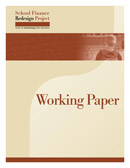in this paper, Julia Koppich looks at an important source of resource allocation decisions—teacher collective bargaining agreements. When school boards enter contracts with teachers unions, they determine the use of nearly half of all the funds available to public education. Provisions about how teachers will be hired, tenured, and distributed among schools and how they are assigned work have profound budgetary consequences, as do measures like salary cost averaging that districts adopt in order to protect teacher placement rights.
As Koppich shows, traditional collective bargaining agreements force a sharp division between labor and management, creating formalistic relationships between people who should work closely together and limiting the effectiveness of school leadership. Koppich argues, however, that teacher interests can be protected via reform-oriented collective bargaining agreements that put student performance first by promoting flexibility and collaborative problem solving at the school level.




